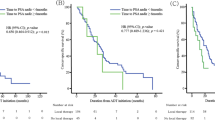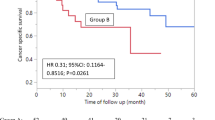Abstract
Overall and biochemical disease-free (bNED) survival data after definitive radiotherapy (RT) for prostate cancer (CaP) requires decades of patient follow-up. Surrogates involving dynamics of prostate-specific antigen (PSA) decline, PSA nadir and time thereto have been unrewarding. This study investigated the metric of the PSA value 100 days after RT (PSA100), analyzed with respect to 8-y bNED survival. A total of 214 patients with T1–3 CaP were treated with definitive RT (defined as dose >66 Gy) in our institution between 1/1/1988 and 12/31/2000. All were subject to continuous follow-up with routine PSA levels. Biochemical failure (77 patients) was defined by the ASTRO criteria (n=67) or by the date of first hormonal therapy for a rising PSA, which did not meet the ASTRO criteria (n=10). No patients were included if they received postoperative radiation, or if hormones were administered prior to bNED recurrence, if any. Patients were stratified by PSA100 values ⩽ or >4.0 ng/ml, and ⩽ or <2.5 ng/ml. Median follow-up was 64.3 months: follow-up data were calculated as of time to last PSA, with data collection as of 12/31/02. Patients with PSA100⩽4.0 ng/ml had 62% 8-y bNED survival, and those with PSA100>4.0 ng/ml had 20% 8-y bNED survival (P<0.001). Use of a PSA100 cutoff of 2.5 ng/ml yielded no significant difference in 8-y bNED survival (P=0.229). Cox proportional analysis revealed that initial PSA (P=0.006), stage (P=0.001) and PSA100⩽4.0 ng/ml (P=0.002) were significantly related to bNED survival, but that age (P=0.887), race (P=0.500), RT dose (P=0.669), Gleason sum (P=0.091), and PSA100⩽2.5 ng/ml (P=0.128) were not. In conclusion, PSA100 using a cutoff of 4 ng/ml is a valuable and reliable surrogate for bNED survival after definitive RT, requiring less follow-up than other metrics. Patients with less values will have only about a 1 in 3 chance of bNED failure at 8 y. Patients with greater values will have a 4 in 5 chance of bNED failure at 8 y.
This is a preview of subscription content, access via your institution
Access options
Subscribe to this journal
Receive 4 print issues and online access
$259.00 per year
only $64.75 per issue
Buy this article
- Purchase on Springer Link
- Instant access to full article PDF
Prices may be subject to local taxes which are calculated during checkout


Similar content being viewed by others
References
Powell C et al. Outcome for surgically staged localized prostate cancer treated with external beam radiation therapy. J Urol 1997; 157: 1754–1759.
Gray CL, Powell CR, Riffenburgh RH, Johnstone PAS . 20-year outcome for patients withT1–3N0 surgically staged prostate cancer treated with external beam radiation therapy. J Urol 2001; 166: 116–118.
Vollmer RT, Montana GS . The dynamics of prostate-specific antigen after definitive radiation therapy for prostate cancer. Clin Cancer Res 1999; 5: 4119–4125.
Johnstone PAS et al. How much do prostate specific antigen levels matter after 10 years? The fate of 10-year clinically recurrence-free survivors after definitive radiotherapy for T1–3N0M0 prostate cancer. Radiat Oncol Invest 1998; 6: 103–108.
Walsh PC . Editorial: Localized prostate cancer—mortality and morbidity. J Urol 1997; 157: 1773.
Ritter MA et al. Prostate-specific antigen as a predictor of radiotherapy response and patterns of failure in localized prostate cancer. J Clin Oncol 1990; 10: 1208–1217.
Zagars GK, Pollack A . The rise and fall of prostate-specific antigen: kinetics of serum prostate-specific antigen levels after radiation therapy for prostate cancer. Cancer 1993; 72: 832–842.
D'Amico AV, Hanks GE . Linear regression analysis using prostate-specific antigen doubling time for predicting tumor biology and clinical outcome in prostate cancer. Cancer 1993; 72: 2638–2643.
Cox RS, Kaplan ID, Bagshaw MA . Prostate-specific antigen kinetics after external beam irradiation for carcinoma of the prostate. Int J Radiat Oncol Biol Phys 1993; 8: 23–31.
Pollack A, Zagars GK, Kavadi VS . Prostate specific antigen doubling time and disease relapse after radiotherapy for prostate cancer. Cancer 1994; 74: 670–678.
Hanlon AL, Moore DF, Hanks GE . Modeling post-radiation prostate-specific antigen dynamics. Predictors of rising post-nadir slope suggest cure in men who remain biochemically free of prostate cancer. Cancer 1998; 83: 130–134.
Hanlon AL, Diratzouian H, Hanks GE . Posttreatment prostate-specific antigen nadir highly predictive of distant failure and death from prostate cancer. Int J Radiat Oncol Biol Phys 2002; 53: 297–303.
Chandra A, Levy LB, Kuban DA . PSA nadir and time to nadir as independent predictors of PSA failure-free survival in prostate carcinoma. Proc RSNA 2002; 225 (P): 320–321, (#334).
Aref I, Eapen L, Agboola O, Bross P . The relationship between biochemical failure and time to nadir in patients treated with external beam therapy for T1–T3 prostate carcinoma. Radiother Oncol 1998; 48: 203–207.
Crook JM et al. Serum prostate-specific antigen profile following radiotherapy for prostate cancer Implications for patterns of failure and definition of cure. Urology 1998; 51: 566–572.
Johnstone PA, Buser AM, Riffenburgh RH . Time to nadir of serum prostate specific antigen (PSA) is independent of outcome for patients with prostate cancer (CaP) treated with radiotherapy. Proc ASCO 1999; 18: 342a (#1318).
Bauer JJ et al. Statistical modeling using preoperative prognostic variables in predicting extracapsular extension and progresion after radical prostatectomy for prostate cancer. Military Med 1998; 163: 615–619.
D'Amico AV et al. Pretreatment nomogram for prostate-specific antigen recurrence after radical prostatectomy or external-beam radiation therapy for clinically localized prostate cancer. J Clin Oncol 1999; 17: 168–172.
Kattan MW et al. Pretreatment nomogram for predicting the outcome of three-dimensional conformal radiotherapy in prostate cancer. J Clin Oncol 2000; 18: 3352–3359.
Zagars GK, Pollack A . The serum prostate-specific antigen level three months after radiotherapy for prostate cancer an early indicator of response to treatment. Radiother Oncol 1994; 30: 121–127.
American Society for Therapeutic Radiology and Oncology. American Society for Therapeutic Radiology and Oncology Consensus Panel Guidelines for PSA following radiation therapy. Int J Radat Oncol Biol Phys 1997; 37: 1035–1041.
Brethauer SA, Magrino TJ, Riffenburgh RH, Johnstone PAS . Management of recurrent colorectal carcinoma. Colorectal Dis 2002; 4: 246–253.
O'Meara WP, Thiringer JK, Johnstone PAS . Follow-up of head and neck cancer patients post-radiotherapy. Radiother Oncol 2003; 66: 323–326.
Johnstone PAS, McFarland JT, Riffenburgh RH, Amling CL . Efficacy of the digital rectal examination after radiotherapy for prostate cancer. J Urol 2001; 166: 1684–1687.
Huben RP . Prostate carcinoma. In: Johnson FE, Virgo KS (eds) Cancer Patient Follow-up. Mosby: St. Louis, MO, 1997; pp 378–389.
Dalbagni G, Fair WR . Prostate cancer counterpoint. In: Johnson FE, Virgo KS (eds). Cancer Patient Follow-up. Mosby: St. Louis, MO, 1997; pp 389–394.
Kakizoe T . Prostate cancer: counterpoint. In: Johnson FE, Virgo KS (eds). Cancer Patient Follow-up. Mosby: St. Louis, MO, 1997; pp 395–400.
Takayama TK, Lange PH . Prostate cancer: counterpoint. In: Johnson FE, Virgo KS (eds). Cancer Patient Follow-up. Mosby: St. Louis, MO, 1997; pp 400–405.
Oh J et al. Current followup strategies after radical prostatectomy: a survey of American Urological Association urologists. J Urol 1999; 161: 520–523.
Jani AB et al. PSA based outcome analysis after radiation therapy for prostate cancer: a new definition of biochemical failure after intervention. Urology 1999; 54: 700–705.
Johnstone PAS et al. The effect of ethnicity on biochemical disease-free outcome in patients with prostate cancer treated with definitive radiation therapy in an equal access healthcare system: a Radiation Oncology report of the Department of Defense Center for Prostate Disease Research. Radiology 2002; 225: 420–426.
Johnstone PAS et al. The effect of age on biochemical disease-free outcome in patients with prostate cancer treated with definitive radiation therapy in an equal-access health care system: A radiation oncology report of the Department of Defense Center for Prostate Disease Research. Int J Radiat Oncol Biol Phys 2003; 55: 964–969.
Acknowledgements
The opinions or assertions contained herein are those of the authors and should not be construed as representing the views of the United States Department of Defense or the United States Government. This analysis was supported by the Center for Prostate Disease Research, a program of the Uniformed Services University of the Health Sciences administered by the Henry M Jackson Foundation for the Advancement of Military Medicine and funded by the US Army Medical Research and Material Command.
Author information
Authors and Affiliations
Corresponding author
Rights and permissions
About this article
Cite this article
Johnstone, P., Williams, S. & Riffenburgh, R. The 100-day PSA: usefulness as surrogate end point for biochemical disease-free survival after definitive radiotherapy of prostate cancer. Prostate Cancer Prostatic Dis 7, 263–267 (2004). https://doi.org/10.1038/sj.pcan.4500736
Received:
Revised:
Accepted:
Published:
Issue Date:
DOI: https://doi.org/10.1038/sj.pcan.4500736



